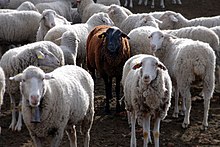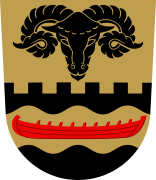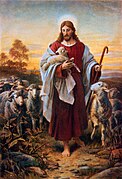Sheep
| Domestic sheep | |
|---|---|
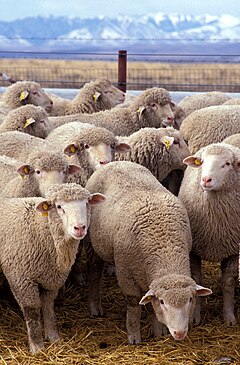
| |
Domesticated
| |
| Scientific classification | |
| Domain: | Eukaryota |
| Kingdom: | Animalia |
| Phylum: | Chordata |
| Class: | Mammalia |
| Order: | Artiodactyla |
| Family: | Bovidae |
| Subfamily: | Caprinae |
| Tribe: | Caprini |
| Genus: | Ovis |
| Species: | O. aries
|
| Binomial name | |
| Ovis aries | |
| Synonyms | |
|
Ovis guineensisLinnaeus, 1758 | |
Sheep(pl.:sheep) ordomestic sheep(Ovis aries) are adomesticated,ruminantmammaltypically kept aslivestock.Although the termsheepcan apply to other species in the genusOvis,in everyday usage it almost always refers to domesticated sheep. Like all ruminants, sheep are members of theorderArtiodactyla,theeven-toed ungulates.Numbering a little over one billion, domestic sheep are also the most numerous species of sheep. An adult female is referred to as aewe(/juː/yoo), an intact male as aram,occasionally atup,acastratedmale as awether,and a young sheep as alamb.
Sheep are most likely descended from the wildmouflonof Europe and Asia, with Iran being a geographic envelope of the domestication center.[1]One of the earliest animals to be domesticated foragriculturalpurposes, sheep are raised forfleeces,meat (lamb, hogget or mutton), andmilk.A sheep'swoolis the most widely used animal fiber, and is usually harvested byshearing.In Commonwealth countries,ovinemeat is calledlambwhen from younger animals andmuttonwhen from older ones; in the United States, meat from both older and younger animals is usually called lamb. Sheep continue to be important for wool and meat today, and are also occasionally raised forpelts,asdairyanimals, or asmodel organismsfor science.
Sheep husbandryis practised throughout the majority of the inhabited world, and has been fundamental to many civilizations. In the modern era,Australia,New Zealand,the southern and centralSouth Americannations, and theBritish Islesare most closely associated with sheep production.
There is a largelexicon of unique termsfor sheep husbandry which vary considerably by region anddialect.Use of the wordsheepbegan inMiddle Englishas a derivation of theOld Englishwordscēap.A group of sheep is called a flock. Many other specific terms for the various life stages of sheep exist, generally related to lambing, shearing, and age.
As a key animal in the history of farming, sheep have a deeply entrenched place in human culture, and are represented in much modern language andsymbolism.As livestock, sheep are most often associated withpastoral,Arcadianimagery. Sheep figure in manymythologies—such as theGolden Fleece—and major religions, especially theAbrahamictraditions. In both ancient and modern religious ritual, sheep are used assacrificial animals.
History
The exact line of descent from wild ancestors to domestic sheep is unclear.[2]The most common hypothesis states thatOvis ariesis descended from the Asiatic (O. gmelini) species ofmouflon;theEuropean mouflon(Ovis aries musimon) is a direct descendant of this population.[3]Sheep were among the first animals to be domesticated by humankind (although the domestication of dogs probably took place 10 to 20 thousand years earlier); the domestication date is estimated to fall between 11,000 and 9000 BC inMesopotamia[4][5][6][7]and possibly around 7000 BC inMehrgarhin the Indus Valley.[8][9]The rearing of sheep for secondary products, and the resulting breed development, began in either southwest Asia or western Europe.[10]Initially, sheep were kept solely for meat, milk and skins. Archaeological evidence fromstatuaryfound at sites inIransuggests that selection for woolly sheep may have begun around 6000 BC,[3][11]and the earliest woven wool garments have been dated to two to three thousand years later.[12]
Sheep husbandry spread quickly in Europe. Excavations show that in about 6000 BC, during theNeolithicperiod of prehistory, the Castelnovien people, living aroundChâteauneuf-les-Martiguesnear present-dayMarseillein the south of France, were among the first in Europe to keep domestic sheep.[13]Practically from its inception,ancient Greek civilizationrelied on sheep as primary livestock, and were even said to name individual animals.[14]Ancient Romanskept sheep on a wide scale, and were an important agent in the spread of sheep raising.Pliny the Elder,in hisNatural History(Naturalis Historia), speaks at length about sheep and wool.[15]European colonists spread the practice to theNew Worldfrom 1493 onwards.[16][17]
Characteristics
Domestic sheep are relatively small ruminants, usually with acrimpedhair called wool and often with horns forming alateralspiral.They differ from their wild relatives and ancestors in several respects, having become uniquelyneotenicas a result of selective breeding by humans.[18][19]A few primitive breeds of sheep retain some of the characteristics of their wild cousins, such as short tails. Depending on breed, domestic sheep may have no horns at all (i.e.polled), or horns in both sexes, or in males only. Most horned breeds have a single pair, but a few breeds may have several.[16]

Another trait unique to domestic sheep as compared to wild ovines is their wide variation in color. Wild sheep are largely variations of brown hues, and variation within species is extremely limited. Colors of domestic sheep range from pure white to dark chocolate brown, and even spotted orpiebald.[20][21]Sheep keepers also sometimes artificially paint "smit marks" onto their sheep in any pattern or color for identification.[22]Selection for easily dyeable white fleeces began early in sheep domestication, and as white wool is adominant traitit spread quickly. However, colored sheep do appear in many modern breeds, and may even appear as arecessivetrait in white flocks.[20][21]While white wool is desirable for large commercial markets, there is aniche marketfor colored fleeces, mostly forhandspinning.[23]The nature of the fleece varies widely among the breeds, from dense and highly crimped, to long and hairlike. There is variation of wool type and quality even among members of the same flock, sowool classingis a step in the commercial processing of the fibre.
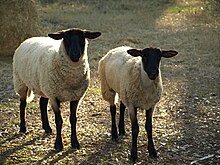
Depending on breed, sheep show a range of heights and weights. Their rate of growth and mature weight is aheritabletrait that is often selected for in breeding.[24]Ewes typically weigh between 45 and 100 kilograms (100 and 220 lb), and rams between 45 and 160 kilograms (100 and 350 lb).[25]When all deciduous teeth have erupted, the sheep has 20 teeth.[26]Mature sheep have 32 teeth. As with other ruminants, the front teeth in the lower jaw bite against a hard, toothless pad in the upper jaw. These are used to pick off vegetation, then the rear teeth grind it before it is swallowed. There are eight lower front teeth in ruminants, but there is some disagreement as to whether these are eightincisors,or six incisors and two incisor-shapedcanines.This means that thedental formulafor sheep is either0.0.3.34.0.3.3or0.0.3.33.1.3.3[27]There is a largediastemabetween theincisorsand themolars.
In the first few years of life one can calculate the age of sheep from their front teeth, as a pair ofmilk teethis replaced by larger adult teeth each year, the full set of eight adult front teeth being complete at about four years of age. The front teeth are then gradually lost as sheep age, making it harder for them to feed and hindering the health and productivity of the animal. For this reason, domestic sheep on normalpasturebegin to slowly decline from four years on, and the life expectancy of a sheep is 10 to 12 years, though some sheep may live as long as 20 years.[16][28][29]

Sheep have good hearing, and are sensitive to noise when being handled.[30]Sheep have horizontal slit-shaped pupils, with excellentperipheral vision;with visual fields of about 270° to 320°, sheep can see behind themselves without turning their heads.[23][31]Many breeds have only short hair on the face, and some have facial wool (if any) confined to the poll and or the area of the mandibular angle; the wide angles of peripheral vision apply to these breeds. A few breeds tend to have considerable wool on the face; for some individuals of these breeds, peripheral vision may be greatly reduced by "wool blindness", unless recently shorn about the face.[32]Sheep have poordepth perception;shadows and dips in the ground may cause sheep to baulk. In general, sheep have a tendency to move out of the dark and into well-lit areas,[33]and prefer to move uphill when disturbed. Sheep also have an excellent sense of smell, and, like all species of their genus, havescent glandsjust in front of the eyes, and interdigitally on the feet. The purpose of these glands is uncertain,[34]but those on the face may be used in breeding behaviors.[24]The foot glands might also be related to reproduction,[24]but alternative functions, such as secretion of a waste product or a scent marker to help lost sheep find their flock, have also been proposed.[34]
Comparison with goats
Sheep andgoatsare closely related: both are in the subfamilyCaprinae.However, they are separate species, sohybridsrarely occur and are always infertile. A hybrid of a ewe and a buck (a male goat) is called asheep-goat hybrid,known asgeep.Visual differences between sheep and goats include the beard of goats and divided upper lip of sheep. Sheep tails also hang down, even when short ordocked,while the short tails of goats are held upwards. Also, sheep breeds are often naturallypolled(either in both sexes or just in the female), while naturally polled goats are rare (though many are polled artificially). Males of the two species differ in that buck goats acquire a unique and strong odor during therut,whereas rams do not.[29]
Breeds
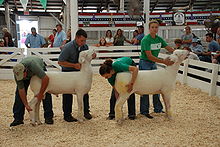
The domestic sheep is a multi-purpose animal, and the more than 200breedsnow in existence were created to serve these diverse purposes.[16][35]Some sources give a count of a thousand or more breeds,[36][37]but these numbers cannot be verified, according to some sources.[23][29]However, several hundred breeds of sheep have been identified by theFood and Agriculture Organization of the UN(FAO), with the estimated number varying somewhat from time to time: e.g. 863 breeds as of 1993,[38]1314 breeds as of 1995[39]and 1229 breeds as of 2006.[40](These numbers exclude extinct breeds, which are also tallied by the FAO.) For the purpose of such tallies, the FAO definition of a breed is "either a subspecific group of domestic livestock with definable and identifiable external characteristics that enable it to be separated by visual appraisal from other similarly defined groups within the same species or a group for which geographical and/or cultural separation from phenotypically similar groups has led to acceptance of its separate identity."[40]Almost all sheep are classified as being best suited to furnishing a certain product: wool, meat, milk, hides, or a combination in a dual-purpose breed. Other features used when classifying sheep include face color (generally white or black), tail length, presence or lack of horns, and thetopographyfor which the breed has been developed. This last point is especially stressed in the UK, where breeds are described as either upland (hill or mountain) or lowland breeds.[33]A sheep may also be of afat-tailed type,which is a dual-purpose sheep common in Africa and Asia with larger deposits of fat within and around its tail.

Breeds are often categorized by the type of their wool. Fine wool breeds are those that have wool of great crimp and density, which are preferred for textiles. Most of these were derived fromMerinosheep, and the breed continues to dominate the world sheep industry. Downs breeds have wool between the extremes, and are typically fast-growing meat and ram breeds with dark faces.[41]Some major medium wool breeds, such as theCorriedale,are dual-purpose crosses of long and fine-wooled breeds and were created for high-production commercial flocks. Long wool breeds are the largest of sheep, with long wool and a slow rate of growth. Long wool sheep are most valued for crossbreeding to improve the attributes of other sheep types. For example: the AmericanColumbiabreed was developed by crossingLincolnrams (a long wool breed) with fine-wooledRambouilletewes.
Coarse orcarpetwool sheep are those with a medium to long length wool of characteristic coarseness. Breeds traditionally used for carpet wool show great variability, but the chief requirement is a wool that will not break down under heavy use (as would that of the finer breeds). As the demand for carpet-quality wool declines, some breeders of this type of sheep are attempting to use a few of these traditional breeds for alternative purposes. Others have always been primarily meat-class sheep.[42]

A minor class of sheep are thedairybreeds. Dual-purpose breeds that may primarily be meat or wool sheep are often used secondarily as milking animals, but there are a few breeds that are predominantly used for milking. These sheep produce a higher quantity of milk and have slightly longer lactation curves.[43]In the quality of their milk, the fat and protein content percentages of dairy sheep vary from non-dairy breeds, but lactose content does not.[44]
A last group of sheep breeds is that of fur orhair sheep,which do not grow wool at all. Hair sheep are similar to the early domesticated sheep kept before woolly breeds were developed, and are raised for meat and pelts. Some modern breeds of hair sheep, such as theDorper,result from crosses between wool and hair breeds. For meat and hide producers, hair sheep are cheaper to keep, as they do not need shearing.[42]Hair sheep are also more resistant to parasites and hot weather.[29]
With the modern rise of corporateagribusinessand the decline of localizedfamily farms,many breeds of sheep are in danger of extinction. TheRare Breeds Survival Trustof the UK lists 22 native breeds as having only 3,000 registered animals (each), andThe Livestock Conservancylists 14 as either "critical" or "threatened".[45][46][47]Preferences for breeds with uniform characteristics and fast growth have pushed heritage (or heirloom) breeds to the margins of the sheep industry.[42]Those that remain are maintained through the efforts of conservation organizations, breed registries, and individual farmers dedicated to their preservation.
Diet
Herbivory

Sheep areherbivorous.Most breeds prefer to graze ongrassand other shortroughage,avoiding the taller woody parts of plants that goats readily consume.[48]Both sheep and goats use theirlipsandtonguesto select parts of the plant that are easier to digest or higher in nutrition.[48]Sheep, however, graze well inmonoculturepastures where most goats fare poorly.[48]
Like all ruminants, sheep have a complexdigestive systemcomposed of four chambers, allowing them to break downcellulosefrom stems, leaves, and seed hulls into simplercarbohydrates.When sheepgraze,vegetation is chewed into a mass called abolus,which is then passed into therumen,via thereticulum.The rumen is a 19- to 38-liter (5 to 10 gallon) organ in which feed isfermented.[49]The fermenting organisms include bacteria, fungi, and protozoa.[50](Other important rumen organisms include some archaea, which produce methane from carbon dioxide.[51]) The bolus is periodically regurgitated back to the mouth ascudfor additional chewing andsalivation.[49]After fermentation in the rumen, feed passes into thereticulumand theomasum;special feeds such as grains may bypass the rumen altogether. After the first three chambers, food moves into theabomasumfor final digestion before processing by theintestines.The abomasum is the only one of the four chambers analogous to the human stomach, and is sometimes called the "true stomach".[52]
Other than forage, the other staple feed for sheep ishay,often during the winter months. The ability to thrive solely on pasture (even without hay) varies with breed, but all sheep can survive on this diet.[42]Also included in some sheep's diets areminerals,either in a trace mix or inlicks.Feed provided to sheep must be specially formulated, as most cattle, poultry, pig, and even some goat feeds contain levels ofcopperthat are lethal to sheep.[23]The same danger applies to mineral supplements such assalt licks.[53]
Grazing behavior

Sheep follow adiurnalpattern of activity, feeding from dawn to dusk, stopping sporadically to rest and chew theircud.Ideal pasture for sheep is not lawnlike grass, but an array ofgrasses,legumesandforbs.[54]Types of land where sheep are raised vary widely, from pastures that are seeded and improved intentionally to rough, native lands. Common plants toxic to sheep are present in most of the world, and include (but are not limited to) cherry, some oaks and acorns, tomato,yew,rhubarb, potato, andrhododendron.[55]
Sheep are largelygrazingherbivores, unlikebrowsinganimals such as goats and deer that prefer taller foliage. With a much narrower face, sheep crop plants very close to the ground and canovergrazea pasture much faster than cattle.[29]For this reason, many shepherds usemanaged intensive rotational grazing,where a flock is rotated through multiple pastures, giving plants time to recover.[29][33]Paradoxically, sheep can both cause and solve the spread ofinvasive plant species.By disturbing the natural state of pasture, sheep and other livestock can pave the way for invasive plants. However, sheep also prefer to eat invasives such ascheatgrass,leafy spurge,kudzuandspotted knapweedover native species such assagebrush,making grazing sheep effective forconservation grazing.[56]Research conducted inImperial County, Californiacompared lamb grazing withherbicidesforweedcontrol in seedlingalfalfafields. Three trials demonstrated that grazing lambs were just as effective as herbicides in controlling winter weeds.Entomologistsalso compared grazing lambs toinsecticidesfor insect control in winter alfalfa. In this trial, lambs provided insect control as effectively as insecticides.[57]
Behavior
Flock behavior


Sheep areflockanimals and strongly gregarious; much sheep behavior can be understood on the basis of these tendencies. Thedominance hierarchyof sheep and their natural inclination to follow a leader to new pastures were the pivotal factors in sheep being one of the first domesticated livestock species.[58]Furthermore, in contrast to thered deerandgazelle(two other ungulates of primary importance to meat production in prehistoric times), sheep do not defendterritoriesalthough they do formhome ranges.[59]All sheep have a tendency to congregate close to other members of a flock, although this behavior varies with breed,[30]and sheep can become stressed when separated from their flock members.[24]During flocking, sheep have a strong tendency to follow, and a leader may simply be the first individual to move. Relationships in flocks tend to be closest among related sheep: in mixed-breed flocks, subgroups of the same breed tend to form, and a ewe and her direct descendants often move as a unit within large flocks.[23]Sheep can becomeheftedto one particular local pasture (heft) so they do not roam freely in unfenced landscapes. Lambs learn the heft from ewes and if whole flocks are culled it must be retaught to the replacement animals.[24][60]
Flock behaviour in sheep is generally only exhibited in groups of four or more sheep; fewer sheep may not react as expected when alone or with few other sheep.[23]Being a prey species, the primary defense mechanism of sheep is to flee from danger when theirflight zoneis entered. Cornered sheep may charge and butt, or threaten by hoof stamping and adopting an aggressive posture. This is particularly true for ewes with newborn lambs.[23]
In regions where sheep have no natural predators, none of the native breeds of sheep exhibit a strong flocking behavior.[29]
Herding
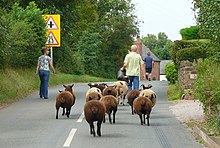
Farmers exploit flocking behavior to keep sheep together on unfenced pastures such ashill farming,and to move them more easily. For this purpose shepherds may useherding dogsin this effort, with a highly bredherdingability. Sheep are food-oriented, and association of humans with regular feeding often results in sheep soliciting people for food.[61]Those who are moving sheep may exploit this behavior by leading sheep with buckets of feed.[62][63]
Dominance hierarchy
Sheep establish adominance hierarchythrough fighting, threats and competitiveness. Dominant animals are inclined to be more aggressive with other sheep, and usually feed first attroughs.[64]Primarily among rams, horn size is a factor in the flock hierarchy.[65]Rams with different size horns may be less inclined to fight to establish the dominance order, while rams with similarly sized horns are more so.[65]Merinoshave an almost linear hierarchy whereas there is a less rigid structure in Border Leicesters when a competitive feeding situation arises.[66]
In sheep, position in a moving flock is highly correlated with social dominance, but there is no definitive study to show consistent voluntary leadership by an individual sheep.[66]
Intelligence and learning ability
Sheep are frequently thought of asunintelligent animals.[67]Their flocking behavior and quickness to flee and panic can make shepherding a difficult endeavor for the uninitiated. Despite these perceptions, aUniversity of Illinoismonographon sheep reported their intelligence to be just below that of pigs and on par with that of cattle.[23]In a study published inNaturein 2001, Kenneth M. Kendrick and others reported; "Sheep recognize and are attracted to individual sheep and humans by their faces, as they possess similar specialized neural systems in thetemporalandfrontal lobes... individual sheep can remember 50 other different sheep faces for over 2 years ".[68][69]In addition to long-term facial recognition of individuals, sheep can also differentiate emotional states through facial characteristics.[68][69]If worked with patiently, sheep may learn their names, and many sheep are trained to be led byhalterfor showing and other purposes.[23]Sheep have also responded well toclicker training.[23]Sheep have been used as pack animals;Tibetannomads distribute baggage equally throughout a flock as it is herded between living sites.[23]
It has been reported that some sheep have apparently shown problem-solving abilities; a flock inWest Yorkshire,Englandallegedly found a way to get overcattle gridsby rolling on their backs, although documentation of this has relied on anecdotal accounts.[70]
Vocalisations
Sounds made by domestic sheep include bleats, grunts, rumbles and snorts. Bleating ( "baaing" ) is used mostly for contact communication, especially between dam and lambs, but also at times between other flock members.[71]The bleats of individual sheep are distinctive, enabling the ewe and her lambs to recognize each other's vocalizations.[72]Vocal communication between lambs and their dam declines to a very low level within several weeks after parturition.[71]A variety of bleats may be heard, depending on sheep age and circumstances. Apart from contact communication, bleating may signal distress, frustration or impatience; however, sheep are usually silent when in pain. Isolation commonly prompts bleating by sheep.[73]Pregnant ewes may grunt when in labor.[74]Rumbling sounds are made by the ram during courting; somewhat similar rumbling sounds may be made by the ewe,[71]especially when with her neonate lambs. A snort (explosive exhalation through the nostrils) may signal aggression or a warning,[71][75]and is often elicited from startled sheep.[76]
Senses


In sheep breeds lacking facial wool, the visual field is wide. In 10 sheep (Cambridge, Lleyn and Welsh Mountain breeds, which lack facial wool), the visual field ranged from 298° to 325°, averaging 313.1°, with binocular overlap ranging from 44.5° to 74°, averaging 61.7°.[77]In some breeds, unshorn facial wool can limit the visual field; in some individuals, this may be enough to cause "wool blindness". In 60 Merinos, visual fields ranged from 219.1° to 303.0°, averaging 269.9°, and the binocular field ranged from 8.9° to 77.7°, averaging 47.5°; 36% of the measurements were limited by wool,[78]although photographs of the experiments indicate that only limited facial wool regrowth had occurred since shearing. In addition to facial wool (in some breeds), visual field limitations can include ears and (in some breeds) horns,[78]so the visual field can be extended by tilting the head. Sheep eyes exhibit very lowhyperopiaand littleastigmatism.Such visual characteristics are likely to produce a well-focused retinal image of objects in both the middle and long distance.[77]Because sheep eyes have noaccommodation,one might expect the image of very near objects to be blurred, but a rather clear near image could be provided by thetapetumand large retinal image of the sheep's eye, and adequate close vision may occur at muzzle length.[77]Good depth perception, inferred from the sheep's sure-footedness, was confirmed in "visual cliff" experiments;[78][79]behavioral responses indicating depth perception are seen in lambs at one day old.[80]Sheep are thought to have colour vision, and can distinguish between a variety of colours: black, red, brown, green, yellow, and white.[81]Sight is a vital part of sheep communication, and when grazing, they maintain visual contact with each other.[82]Each sheep lifts its head upwards to check the position of other sheep in the flock. This constant monitoring is probably what keeps the sheep in a flock as they move along grazing. Sheep become stressed when isolated; this stress is reduced if they are provided with a mirror, indicating that the sight of other sheep reduces stress.[83]
Taste is the most important sense in sheep, establishing forage preferences, with sweet and sour plants being preferred and bitter plants being more commonly rejected. Touch and sight are also important in relation to specific plant characteristics, such as succulence and growth form.[84]
The ram uses hisvomeronasalorgan (sometimes called the Jacobson's organ) to sense the pheromones of ewes and detect when they are inestrus.[85]The ewe uses her vomeronasal organ for early recognition of her neonate lamb.[86]
Reproduction
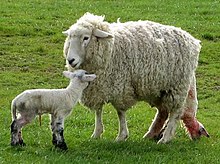
Sheep follow a similarreproductivestrategy to other herd animals. A group of ewes is generally mated by a single ram, who has either been chosen by a breeder or (inferalpopulations) has established dominance through physical contest with other rams.[42]Most sheep areseasonal breeders,although some are able to breed year-round.[42]Ewes generally reach sexual maturity at six to eight months old, and rams generally at four to six months.[42]However, there are exceptions. For example, Finnsheep ewe lambs may reach puberty as early as 3 to 4 months, and Merino ewes sometimes reach puberty at 18 to 20 months.[87]Ewes haveestruscycles about every 17 days,[88]during which they emit a scent and indicate readiness through physical displays towards rams.
In feral sheep, rams may fight during therutto determine which individuals may mate with ewes. Rams, especially unfamiliar ones, will also fight outside the breeding period to establish dominance; rams can kill one another if allowed to mix freely.[42]During the rut, even usually friendly rams may become aggressive towards humans due to increases in their hormone levels.[24]
After mating, sheep have agestationperiod of about five months,[89]and normal labor takes one to three hours.[90]Although some breeds regularly throw larger litters of lambs, most produce single or twin lambs.[24][91]During or soon after labor, ewes and lambs may be confined to smalllambing jugs,[92]small pens designed to aid both careful observation of ewes and to cement the bond between them and their lambs.[33][42]

Ovineobstetricscan be problematic. By selectively breeding ewes that produce multiple offspring with higher birth weights for generations, sheep producers have inadvertently caused some domestic sheep to have difficulty lambing; balancing ease of lambing with high productivity is one of the dilemmas of sheep breeding.[93]In the case of any such problems, those present at lambing may assist the ewe by extracting or repositioning lambs.[42]After the birth, ewes ideally break theamniotic sac(if it is not broken during labor), and begin licking clean the lamb.[42]Most lambs will begin standing within an hour of birth.[42]In normal situations, lambs nurse after standing, receiving vitalcolostrummilk. Lambs that either fail to nurse or are rejected by the ewe require help to survive, such as bottle-feeding or fostering by another ewe.[94]
Most lambs begin life being born outdoors. After lambs are several weeks old,lamb marking(ear tagging,docking,mulesing,andcastrating) is carried out.[42]Vaccinations are usually carried out at this point as well. Ear tags with numbers are attached, or ear marks are applied, for ease of later identification of sheep. Docking and castration are commonly done after 24 hours (to avoid interference with maternal bonding and consumption of colostrum) and are often done not later than one week after birth, to minimize pain, stress, recovery time and complications.[95][96]The first course of vaccinations (commonly anti-clostridial) is commonly given at an age of about 10 to 12 weeks; i.e. when the concentration of maternal antibodies passively acquired via colostrum is expected to have fallen low enough to permit development of active immunity.[97][98][99]Ewes are often revaccinated annually about 3 weeks before lambing, to provide high antibody concentrations in colostrum during the first several hours after lambing.[100]Ram lambs that will either be slaughtered or separated from ewes before sexual maturity are not usually castrated.[33]Objections to all these procedures have been raised by animal rights groups, but farmers defend them by saying they save money, and inflict only temporary pain.[24][42]
Sheep are the only species of mammal except for humans which exhibitexclusive homosexual behavior.[101][102][103]About 10% of rams refuse to mate with ewes but readily mate with other rams,[102]and thirty percent of all rams demonstrate at least some homosexual behavior.[104][105]Additionally, a small number of females that were accompanied by a male fetusin utero(i.e. asfraternal twins) arefreemartins(female animals that are behaviorally masculine and lack functioningovaries).[106][107][108][109]
Health

Sheep may fall victim to poisons,infectious diseases,and physical injuries. As a prey species, a sheep's system is adapted to hide the obvious signs of illness, to prevent being targeted by predators.[24]However, some signs of ill health are obvious, with sick sheep eating little, vocalizing excessively, and being generally listless.[110]Throughout history, much of the money and labor of sheep husbandry has aimed to prevent sheep ailments. Historically, shepherds often created remedies by experimentation on the farm. In some developed countries, including the United States, sheep lack the economic importance for drug companies to perform expensive clinical trials required to approve more than a relatively limited number of drugs for ovine use.[111]However, extra-label drug use in sheep production is permitted in many jurisdictions, subject to certain restrictions. In the US, for example, regulations governing extra-label drug use in animals are found in 21 CFR (Code of Federal Regulations) Part 530.[112]In the 20th and 21st centuries, a minority of sheep owners have turned to alternative treatments such ashomeopathy,herbalismand eventraditional Chinese medicineto treat sheep veterinary problems.[23][24]Despite some favorableanecdotal evidence,the effectiveness of alternative veterinary medicine has been met with skepticism inscientific journals.[23][24][113]The need for traditional anti-parasite drugs andantibioticsis widespread, and is the main impediment to certifiedorganic farmingwith sheep.[42]
Many breeders take a variety ofpreventive measuresto ward off problems. The first is to ensure all sheep are healthy when purchased. Many buyers avoid outlets known to be clearing houses for animals culled from healthy flocks as either sick or simply inferior.[24]This can also mean maintaining a closed flock, andquarantiningnew sheep for a month. Two fundamental preventive programs are maintaining good nutrition and reducing stress in the sheep. Restraint, isolation, loud noises, novel situations, pain, heat, extreme cold, fatigue and other stressors can lead to secretion of cortisol, a stress hormone, in amounts that may indicate welfare problems.[114][115][116][117]Excessive stress can compromise the immune system.[117]"Shipping fever" (pneumonic mannheimiosis, formerly called pasteurellosis) is a disease of particular concern, that can occur as a result of stress, notably during transport and (or) handling.[118][119]Pain, fear and several other stressors can cause secretion of epinephrine (adrenaline). Considerable epinephrine secretion in the final days before slaughter can adversely affect meat quality (by causing glycogenolysis, removing the substrate for normal post-slaughter acidification of meat) and result in meat becoming more susceptible to colonization by spoilage bacteria.[115]Because of such issues, low-stress handling is essential in sheep management. Avoiding poisoning is also important; common poisons arepesticidesprays, inorganicfertilizer,motor oil,as well as radiator coolant containing ethylene glycol.[120]

Common forms of preventive medication for sheep arevaccinationsand treatments forparasites.Both external and internal parasites are the most prevalent malady in sheep, and are either fatal, or reduce the productivity of flocks.[24]Wormsare the most common internal parasites. They are ingested during grazing, incubate within the sheep, and are expelled through the digestive system (beginning the cycle again). Oral anti-parasitic medicines, known asdrenches,are given to a flock to treat worms, sometimes after worm eggs in the feces has been counted to assess infestation levels. Afterwards, sheep may be moved to a new pasture to avoid ingesting the same parasites.[33]External sheep parasites include: lice (for different parts of the body), sheepkeds,nose bots,sheep itch mites,andmaggots.Keds are blood-sucking parasites that cause general malnutrition and decreased productivity, but are not fatal. Maggots are those of thebot flyand theblow-fly,commonlyLucilia sericataor its relativeL. cuprina.Fly maggots cause the extremely destructive condition offlystrike.Flies lay their eggs in wounds or wet, manure-soiled wool; when the maggots hatch they burrow into a sheep's flesh, eventually causing death if untreated. In addition to other treatments,crutching(shearing wool from a sheep's rump) is a common preventive method. Some countries allowmulesing,a practice that involves stripping away the skin on the rump to prevent fly-strike, normally performed when the sheep is a lamb.[121][122]Nose bots are fly larvae that inhabit a sheep'ssinuses,causing breathing difficulties and discomfort. Common signs are a discharge from the nasal passage, sneezing, and frantic movement such as head shaking. External parasites may be controlled through the use ofbackliners,sprays or immersivesheep dips.[24]

A wide array of bacterial and viral diseases affect sheep. Diseases of the hoof, such asfoot rotand foot scald may occur, and are treated with footbaths and other remedies.Foot rotis present in over 97% of flocks in the UK.[123]These painful conditions cause lameness and hinder feeding. OvineJohne's diseaseis a wasting disease that affects young sheep.Bluetongue diseaseis an insect-borne illness causing fever and inflammation of themucous membranes.Ovine rinderpest(orpeste des petits ruminants) is a highly contagious and often fatalviraldisease affecting sheep and goats. Sheep may also be affected by primary[124]or secondary photosensitization.Tetanuscan also afflict sheep through wounds fromshearing,docking,castration,or vaccination. The organism also can be introduced into the reproductive tract by unsanitary humans who assist ewes during lambing.[125]
A few sheep conditions are transmissible to humans.Orf(also known as scabby mouth, contagious ecthyma or soremouth) is a skin disease leaving lesions that is transmitted through skin-to-skin contact. Cutaneousanthraxis also called woolsorter's disease, as the spores can be transmitted in unwashed wool. More seriously, the organisms that can cause spontaneous enzooticabortionin sheep are easily transmitted to pregnant women. Also of concern are thepriondiseasescrapieand thevirusthat causesfoot-and-mouth disease(FMD), as both can devastate flocks. The latter poses a slight risk to humans. During the 2001 FMD pandemic in the UK, hundreds of sheep were culled and some rare British breeds were at risk of extinction due to this.[24]
Of the 600,300 sheep lost to the US economy in 2004, 37.3% were lost to predators, while 26.5% were lost to some form of disease. Poisoning accounted for 1.7% of non-productive deaths.[126]
Predators
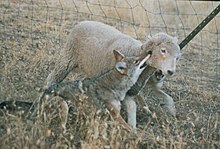
Other than parasites and disease,predationis a threat to sheep and the profitability of sheep raising. Sheep have little ability to defend themselves, compared with other species kept as livestock. Even if sheep survive an attack, they may die from their injuries or simply from panic.[24]However, the impact of predation varies dramatically with region. In Africa, Australia, the Americas, and parts of Europe and Asia predators are a serious problem. In the United States, for instance, over one third of sheep deaths in 2004 were caused by predation.[126]In contrast, other nations are virtually devoid of sheep predators, particularly islands known for extensive sheep husbandry.[24]Worldwide,canids—including the domestic dog—are responsible for most sheep deaths.[127][128][129]Other animals that occasionally prey on sheep include: felines, bears, birds of prey, ravens andferal hogs.[126][130]
Sheep producers have used a wide variety of measures to combat predation. Pre-modern shepherds used their own presence,livestock guardian dogs,and protective structures such as barns and fencing. Fencing (both regular andelectric), penning sheep at night and lambing indoors all continue to be widely used.[42]More modern shepherds used guns,traps,and poisons to kill predators,[131]causing significant decreases in predator populations. In the wake of the environmental and conservation movements, the use of these methods now usually falls under the purview of specially designated government agencies in most developed countries.[132]
The 1970s saw a resurgence in the use of livestock guardian dogs and the development of new methods of predator control by sheep producers, many of them non-lethal.[33]Donkeys andguard llamashave been used since the 1980s in sheep operations, using the same basic principle as livestock guardian dogs.[24]Interspecific pasturing, usually with larger livestock such as cattle or horses, may help to deter predators, even if such species do not actively guard sheep.[42]In addition to animal guardians, contemporary sheep operations may use non-lethal predator deterrents such as motion-activated lights and noisy alarms.[24]
Economic importance
| Global sheep stock | |
|---|---|
| in 2019 | |
| Number in millions | |
| 1. China | 163.5(13.19%) |
| 2. India | 74.3(5.99%) |
| 3. Australia | 65.8(5.31%) |
| 4. Nigeria | 46.9(3.78%) |
| 5. Iran | 41.3(3.33%) |
| 6. Sudan | 40.9(3.3%) |
| 7. Chad | 35.9(2.9%) |
| 8. Turkey | 35.2(2.84%) |
| 9. United Kingdom | 33.6(2.71%) |
| 10. Mongolia | 32.3(2.61%) |
| World total | 1,239.8 |
| Source: UNFood and Agriculture Organization | |
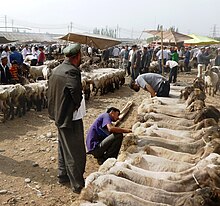
Sheep are an important part of the global agricultural economy. However, their once vital status has been largely replaced by other livestock species, especially the pig, chicken, and cow.[33]China,Australia,India,andIranhave the largest modern flocks, and serve both local and exportation needs for wool and mutton.[133]Other countries such as New Zealand have smaller flocks but retain a large international economic impact due to their export of sheep products. Sheep also play a major role in many local economies, which may be niche markets focused on organic orsustainable agricultureandlocal foodcustomers.[23][134]Especially indeveloping countries,such flocks may be a part ofsubsistence agriculturerather than a system of trade. Sheep themselves may be a medium of trade inbarter economies.[23]

Domestic sheep provide a wide array of raw materials. Wool was one of the first textiles, although in the late 20th century wool prices began to fall dramatically as the result of the popularity and cheap prices forsynthetic fabrics.[23]For many sheep owners, the cost of shearing is greater than the possible profit from the fleece, making subsisting on wool production alone practically impossible withoutfarm subsidies.[23]Fleeces are used as material in making alternative products such aswool insulation.[135]In the 21st century, the sale of meat is the most profitable enterprise in the sheep industry, even though far less sheep meat is consumed than chicken, pork or beef.[33]
Sheepskinis likewise used for making clothes, footwear, rugs, and other products. Byproducts from the slaughter of sheep are also of value: sheeptallowcan be used in candle and soap making, sheep bone andcartilagehas been used to furnish carved items such as dice and buttons as well as rendered glue andgelatin.[136]Sheepintestinecan be formed into sausage casings, and lamb intestine has been formed intosurgical sutures,as well as strings for musical instruments and tennis rackets.[16]Sheep droppings, which are high incellulose,have even been sterilized and mixed with traditionalpulpmaterials to make paper.[137]Of all sheep byproducts, perhaps the most valuable islanolin:the waterproof, fatty substance found naturally in sheep's wool and used as a base for innumerablecosmeticsand other products.[16]
Some farmers who keep sheep also make a profit from live sheep. Providing lambs for youth programs such as4-Hand competition atagricultural showsis often a dependable avenue for the sale of sheep.[138]Farmers may also choose to focus on a particular breed of sheep in order to sell registeredpurebredanimals, as well as provide a ram rental service for breeding.[139]A new option for deriving profit from live sheep is the rental of flocks for grazing; these "mowingservices "are hired in order to keep unwanted vegetation down in public spaces and to lessenfire hazard.[140]
Despite the falling demand and price for sheep products in many markets, sheep have distinct economic advantages when compared with other livestock. They do not require expensive housing,[141]such as that used in theintensive farmingof chickens or pigs. They are an efficient use of land; roughly six sheep can be kept on the amount that would suffice for a single cow or horse.[24][142]Sheep can also consume plants, such as noxious weeds, that most other animals will not touch, and produce more young at a faster rate.[143]Also, in contrast to most livestock species, the cost of raising sheep is not necessarily tied to the price of feed crops such as grain, soybeans and corn.[144]Combined with the lower cost of quality sheep, all these factors combine to equal a loweroverheadfor sheep producers, thus entailing a higher profitability potential for the small farmer.[144]Sheep are especially beneficial for independent producers, including family farms with limited resources, as the sheep industry is one of the few types of animal agriculture that has not beenvertically integratedbyagribusiness.[145]However, small flocks, from 10 to 50 ewes, often are not profitable because they tend to be poorly managed. The primary reason is that mechanization is not feasible, so return per hour of labor is not maximized. Small farm flocks generally are used simply to control weeds on irrigation ditches or maintained as a hobby.[146]
As food
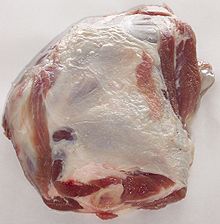
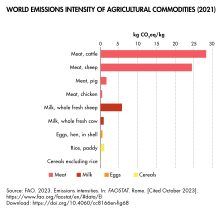
Sheep meat and milk were one of the earliest staple proteins consumed by human civilization after the transition fromhunting and gatheringto agriculture.[24]Sheep meat prepared for food is known as either mutton or lamb, and approximately 540 million sheep are slaughtered each year for meat worldwide.[147]"Mutton" is derived from theOld Frenchmoton,which was the word for sheep used by theAnglo-Normanrulers of much of the British Isles in theMiddle Ages.This became the name for sheep meat in English, while theOld Englishwordsceapwas kept for the live animal.[148]Throughout modern history, "mutton" has been limited to the meat of mature sheep usually at least two years of age; "lamb" is used for that of immature sheep less than a year.[149][150][151]
In the 21st century, the nations with the highest consumption of sheep meat are theArab states of the Persian Gulf,New Zealand, Australia,Greece,Uruguay,the United Kingdom and Ireland.[23]These countries eat 14–40 lbs (3–18 kg) of sheep meatper capita,per annum.[23][151]Sheep meat is also popular inFrance,Africa (especially theArab world), theCaribbean,the rest of theMiddle East,India,and parts ofChina.[151]This often reflects a history of sheep production. In these countries in particular, dishes comprising alternative cuts andoffalmay be popular or traditional. Sheeptesticles—calledanimellesorlamb fries—are considered a delicacy in many parts of the world. Perhaps the most unusual dish of sheep meat is the Scottishhaggis,composed of various sheepinnardscooked along with oatmeal and chopped onions inside its stomach.[152]In comparison, countries such as the U.S. consume only a pound or less (under 0.5 kg), with Americans eating 50 pounds (22 kg) of pork and 65 pounds (29 kg) of beef.[151]In addition, such countries rarely eat mutton, and may favor the more expensive cuts of lamb: mostlylamb chopsandleg of lamb.[23]
Though sheep's milk may be drunk rarely in fresh form,[153]today it is used predominantly in cheese and yogurt making. Sheep have only twoteats,and produce a far smaller volume of milk than cows.[24]However, as sheep's milk contains far more fat,solids,and minerals than cow's milk, it is ideal for the cheese-making process.[44]It also resists contamination during cooling better because of its much highercalciumcontent.[44]Well-known cheeses made from sheep milk include thefetaofBulgariaandGreece,Roquefortof France,Manchegofrom Spain, thepecorino romano(theItalianword for "sheep" ispecore) andricottaofItaly.Yogurts, especially some forms ofstrained yogurt,may also be made from sheep milk.[154]Many of these products are now often made with cow's milk, especially when produced outside their country of origin.[23]Sheep milk contains 4.8%lactose,which may affect those who areintolerant.[23]
As with other domestic animals, the meat of uncastrated males is inferior in quality, especially as they grow. A "bucky" lamb is a lamb which was not castrated early enough, or which was castrated improperly (resulting in one testicle being retained). These lambs are worth less at market.[155][156][157]
In science

Sheep are generally too large and reproduce too slowly to make ideal research subjects, and thus are not a commonmodel organism.[158]They have, however, played an influential role in some fields of science. In particular, theRoslin InstituteofEdinburgh, Scotlandused sheep forgeneticsresearch that produced groundbreaking results. In 1995, two ewes namedMegan and Moragwere the first mammalsclonedfromdifferentiated cells,also referred to asgynomerogony.A year later, aFinnish Dorsetsheep namedDolly,dubbed "the world's most famous sheep" inScientific American,[159]was the first mammal to beclonedfrom an adultsomatic cell.Following this,Polly and Mollywere the first mammals to be simultaneously cloned andtransgenic.
As of 2008, the sheepgenomehas not been fully sequenced, although a detailedgenetic maphas been published,[160]and a draft version of the complete genome produced by assembling sheep DNA sequences using information given by the genomes of other mammals.[161]In 2012, atransgenicsheep named "Peng Peng" was cloned by Chinese scientists, who spliced his genes with that of a roundworm (C. elegans) in order to increase production of fats healthier for human consumption.[162]
In the study ofnatural selection,the population ofSoay sheepthat remain on the island ofHirtahave been used to explore the relation of body size and coloration to reproductive success.[163]Soay sheep come in several colors, and researchers investigated why the larger, darker sheep were in decline; this occurrence contradicted the rule of thumb that larger members of a population tend to be more successful reproductively.[164]The feral Soays on Hirta are especially useful subjects because they are isolated.[165]
Domestic sheep are sometimes used in medical research, particularly for researching cardiovascular physiology, in areas such ashypertensionandheart failure.[166][167]Pregnant sheep are also a useful model for human pregnancy,[168]and have been used to investigate the effects on fetal development ofmalnutritionandhypoxia.[169]Inbehavioral sciences,sheep have been used in isolated cases for the study offacial recognition,as their mental process of recognition is qualitatively similar to humans.[170]
In culture
Folklore and literature
Sheep have had a strong presence in many cultures, especially in areas where they form the most common type of livestock. In the English language, to call someone a sheep or ovine may allude that they are timid and easily led.[171]In contradiction to this image, male sheep are often used as symbols of virility and power; the logos of theLos Angeles Ramsfootball team and theDodge Rampickup truck allude to males of thebighorn sheep,Ovis canadensis.
Counting sheepis popularly said to be an aid to sleep, and someancient systems of counting sheeppersist today. Sheep also enter in colloquial sayings andidiomfrequently with such phrases as "black sheep".To call an individual a black sheep implies that they are an odd or disreputable member of a group.[172]This usage derives from the recessive trait that causes an occasional black lamb to be born into an entirely white flock. These black sheep were considered undesirable by shepherds, as black wool is not as commercially viable as white wool.[172]Citizens who accept overbearing governments have been referred to by thePortmanteauneologismofsheeple.Somewhat differently, the adjective "sheepish" is also used to describe embarrassment.[173]
In Britishheraldry,sheep appear in the form of rams, sheep proper and lambs. These are distinguished by the ram being depicted with horns and a tail, the sheep with neither and the lamb with its tail only. A further variant of the lamb, termed thePaschal lamb,is depicted as carrying aChristian crossand with ahaloover its head. Rams' heads, portrayed without a neck and facing the viewer, are also found in British armories. The fleece, depicted as an entire sheepskin carried by a ring around its midsection, originally became known through its use in the arms of theOrder of the Golden Fleeceand was later adopted by towns and individuals with connections to the wool industry.[174]InAustralian Englishslang, "on the sheep's back" is a phrase used to allude to wool as the source of Australia’s national prosperity.[175]
Sheep are key symbols infablesandnursery rhymeslikeThe Wolf in Sheep's Clothing,Little Bo Peep,Baa, Baa, Black Sheep,andMary Had a Little Lamb;novels such asGeorge Orwell'sAnimal FarmandHaruki Murakami'sA Wild Sheep Chase;songs such asBach'sSheep may safely graze(Schafe können sicher weiden) andPink Floyd's "Sheep",and poems likeWilliam Blake's "The Lamb".
-
The proverbial black sheep
-
Head of ram pictured in the former coat of arms ofSääminki,Finland
-
Nicolaes Pieterszoon Berchem(1620–1683),Sheep,black and red chalk (possibly crayon)
Religion
In antiquity, symbolism involving sheep cropped up in religions in theancient Near East,theMideast,and theMediterraneanarea:Çatalhöyük,ancient Egyptian religion, the Cana'anite and Phoenician tradition,Judaism,Greek religion,and others. Religious symbolism and ritual involving sheep began with some of the first known faiths: Skulls of rams (along with bulls) occupied central placement in shrines at the Çatalhöyük settlement in 8,000 BCE.[176]InAncient Egyptian religion,the ram was the symbol of several gods:Khnum,HeryshafandAmun(in his incarnation as a god offertility).[23]Other deities occasionally shown with ram features include the goddessIshtar,thePhoeniciangod Baal-Hamon, and the Babylonian god Ea-Oannes.[23]In Madagascar, sheep were not eaten as they were believed to be incarnations of the souls of ancestors.[177]
There are many ancient Greek references to sheep: that ofChrysomallos,the golden-fleeced ram, continuing to be told through into the modern era.Astrologically,Aries,the ram, is the first sign of the classical Greekzodiac,and the sheep is the eighth of the twelve animals associated with the 12-year cycle of in theChinese zodiac,related to theChinese calendar.[177]It is said in Chinese traditions thatHou jisacrificed sheep.Mongolia,shagaiare an ancient form of dice made from thecuboid bonesof sheep that are often used for fortunetelling purposes.
Sheep play an important role in all the Abrahamic faiths;Abraham,Isaac,Jacob,Moses,andKing Davidwere all shepherds. According to the Biblical story of theBinding of Isaac,a ram is sacrificed as a substitute for Isaac after an angel stays Abraham's hand (in the Islamic tradition, Abraham was about to sacrifice Ishmael).Eid al-Adhais a major annual festival inIslamin which sheep (or other animals) are sacrificed in remembrance of this act.[178][179]Sheep are occasionally sacrificed to commemorate importantsecularevents in Islamic cultures.[180]Greeks and Romans sacrificed sheep regularly in religious practice, andJudaismonce sacrificed sheep as aKorban(sacrifice), such as thePassover lamb.[177]Ovine symbols—such as the ceremonial blowing of ashofar—still find a presence in modern Judaic traditions.
Collectively, followers ofChristianityare often referred to as a flock, with Christ as theGood Shepherd,and sheep are an element in the Christianiconographyof thebirth of Jesus.Some Christiansaintsare consideredpatrons of shepherds,and even of sheep themselves. Christ is also portrayed as theSacrificial lambof God (Agnus Dei) and Easter celebrations inGreeceandRomaniatraditionally feature a meal of Paschal lamb. A church leader is often called thepastor,which is derived from the Latin word for shepherd. In many western Christian traditions bishops carry a staff, which also serves as a symbol of the episcopal office, known as acrosier,modeled on theshepherd's crook.
-
Jesusis depicted as "The Good Shepherd", and the Christians as sheep.
See also
- Dry Sheep Equivalent
- Fictional sheep
- Rava sheep
- Sheepfold
- U.S. Sheep Experiment Station
- Venray sheep companies
- Sheep–goat hybrid
- Calico sheep
References
- ^Alberto, Florian J.; Boyer, Frédéric; Orozco-Terwengel, Pablo; Streeter, Ian; Servin, Bertrand; De Villemereuil, Pierre; Benjelloun, Badr; Librado, Pablo; Biscarini, Filippo; Colli, Licia; Barbato, Mario; Zamani, Wahid; Alberti, Adriana; Engelen, Stefan; Stella, Alessandra; Joost, Stéphane; Ajmone-Marsan, Paolo; Negrini, Riccardo; Orlando, Ludovic; Rezaei, Hamid Reza; Naderi, Saeid; Clarke, Laura; Flicek, Paul; Wincker, Patrick; Coissac, Eric; Kijas, James; Tosser-Klopp, Gwenola; Chikhi, Abdelkader; Bruford, Michael W.; et al. (2018)."Convergent genomic signatures of domestication in sheep and goats".Nature.9(1): 813.Bibcode:2018NatCo...9..813A.doi:10.1038/s41467-018-03206-y.PMC5840369.PMID29511174.S2CID3684417.
- ^Hiendleder S, Kaupe B, Wassmuth R, Janke A (2002)."Molecular analysis of wild and domestic sheep questions current nomenclature and provides evidence for domestication from two different subspecies".Proc. Biol. Sci.269(1494): 893–904.doi:10.1098/rspb.2002.1975.PMC1690972.PMID12028771.
- ^abEnsminger, p. 5
- ^Ensminger, p. 4
- ^Weaver, pp. 11–14
- ^Simmons & Ekarius, p. 2
- ^Krebs, Robert E.; Carolyn A. (2003).Groundbreaking Scientific Experiments, Inventions & Discoveries of the Ancient World.Westport, CT: Greenwood Press.ISBN978-0-313-31342-4.
- ^Franke, Ute (January 2016)."Prehistoric Balochistan: Cultural Developments in an Arid Region".In Markus Reindel; Karin Bartl; Friedrich Lüth;Norbert Benecke(eds.).Palaeoenvironment and the Development of Early Settlements.ISBN978-3-86757-395-5.Archivedfrom the original on 15 March 2022.Retrieved31 July2020.
- ^Meadow, Richard H. (1991).Harappa Excavations 1986–1990 A Multidisciplinary Approach to Third Millennium Urbanism.Madison Wisconsin: PREHISTORY PRESS. pp. 94 Moving east to the Greater Indus Valley, decreases in the size of cattle, goat, and sheep also appear to have taken place starting in the 6th or even 7th Millennium BC (Meadow 1984b, 1992). Details of that phenomenon, which I have argued elsewhere was a local process at least for sheep and cattle (Meadow 1984b, 1992).
- ^Chessa, B.; Pereira, F.; Arnaud, F.; et al. (2009)."Revealing the History of Sheep Domestication Using Retrovirus Integrations".Science.324(5926): 532–536.Bibcode:2009Sci...324..532C.doi:10.1126/science.1170587.PMC3145132.PMID19390051.
- ^Weaver, p. 11
- ^Smith et al., p. 8
- ^Max Escalon de Fonton,L'Homme avant l'histoire,p. 16–17, inHistoire de la Provence,Editions Privat, Toulouse, 1990. See also F. Bourdier,Préhistoire de France(Paris, 1967) and G. Bailloud,Les civilisations Néolithiques de la France(Paris, 1955).
- ^Weaver, p. 13
- ^Pliny the Elder(1855) [77]."Naturalis Historia".Perseus Digital Library.Tufts University. pp. Chapters 72–75.Archivedfrom the original on 7 January 2010.Retrieved29 December2007.
- ^abcdefEnsminger
- ^Weaver, p. 12
- ^Budiansky, pp. 97–98.
- ^Budianksy, pp. 100–01.
- ^ab"Natural Colored Sheep".Rare Breeds Watchlist.Rocky Mountain Natural Colored Sheep Breeders Association. January 2007.Archivedfrom the original on 24 June 2013.Retrieved5 January2008.
- ^ab"An introduction to coloured sheep".British Coloured Sheep Breeders Association.Archived fromthe originalon 10 November 2007.Retrieved5 January2008.
- ^Longhi, Cassandra (29 September 2021)."Why do sheep have paint on them?".Retrieved26 January2023.
- ^abcdefghijklmnopqrstuvwxWeaver
- ^abcdefghijklmnopqrstuvwSimmons & Ekarius
- ^Melinda J. Burrill (2004). "Sheep".World Book.Mackiev.
- ^Frandson, R. D. and T. L. Spurgeon. 1992. Anatomy and physiology of farm animals. 5th ed. Lippincott, Williams and Wilkins.
- ^"Dental Anatomy of Ruminants from Colorado State University".Vivo.colostate.edu.7 November 2001.Archivedfrom the original on 28 September 2011.Retrieved14 April2014.
- ^Schoenian, Susan."Sheep Basics".Sheep101.info.Archivedfrom the original on 15 November 2007.Retrieved27 November2007.
- ^abcdefgSmith et al.
- ^abSmith et al., p. 5.
- ^Shulaw, William P. (2006).Sheep Care Guide.American Sheep Industry Association.Archivedfrom the original on 9 August 2019.Retrieved8 September2008.
- ^Terrill, C. E.; Hazel, L. N. (1946). "Heritability of neck folds and face covering in range Rambouillet lambs as evaluated by scoring".J. Anim. Sci.5(2): 170–179.doi:10.2527/jas1946.52170x.PMID20985519.
- ^abcdefghiBrown, Dave; Sam Meadowcroft (1996).The Modern Shepherd.Ipswich, United Kingdom: Farming Press.ISBN978-0-85236-188-7.
- ^abSmith et al., p. 4.
- ^"Sheep (Ovis aries)".Breeds of Livestock.Oklahoma State University Dept. of Animal Science.Archivedfrom the original on 6 November 2007.Retrieved2 November2007.
- ^Cathy M. Dwyer (31 July 2008).The Welfare of Sheep.シュプリンガー・ジャパン kabushiki gaisha. pp. 56–.ISBN978-1-4020-8552-9.Archivedfrom the original on 11 May 2013.Retrieved15 October2010.
- ^Per Jensen (2009).The ethology of domestic animals: an introductory text.CABI. pp. 162–.ISBN978-1-84593-536-8.Archivedfrom the original on 11 May 2013.Retrieved15 October2010.
- ^Maijala, K. 1997, Genetic aspects of domestication, common breeds and their origin. In: Piper, L. and A. Ruvinsky (eds.). The genetics of sheep. CABI
- ^Scherf, B. D. 2000. World watch list for domestic animal diversity. 3rd Edition. FAO, Rome
- ^abFAO. 2007. State of the world's animal genetic resources for food and agriculture
- ^D’Arcy, J.B., Sheep Management & Wool Technology, NSW University Press, 1986,ISBN0-86840-106-4
- ^abcdefghijklmnopqWooster
- ^Pulina, Giuseppe; Roberta Bencini (2004).Dairy Sheep Nutrition.CABI Publishing.ISBN978-0-85199-595-3.Archivedfrom the original on 15 March 2022.Retrieved1 November2020.
- ^abcPulina et al. p. 2.
- ^Rare Breeds Survival Trust(UK) (January 2008)."Sheep".Rare Breeds Watchlist.Archived fromthe originalon 22 June 2008.Retrieved7 September2008.
- ^Rare Breeds Survival Trust(UK) (2008)."Watchlist".A numerical guide to the 2008 Watchlist categories.Archived fromthe originalon 31 July 2008.Retrieved7 September2008.
- ^"Conservation Priority List",livestockconservancy.org,The Livestock Conservancy,archivedfrom the original on 25 October 2010,retrieved3 September2013
- ^abcPugh, pp. 19.
- ^abSimmons & Ekarius, p. 146.
- ^Van Soest, P. J. 1994. Nutritional ecology of the ruminant. 2nd ed. Cornell Univ. Press. 476 pp.
- ^Wright, A.-D. G.; et al. (2004)."Molecular diversity of rumen methanogens from sheep in Western Australia".Appl. Environ. Microbiol.70(3): 1263–1270.Bibcode:2004ApEnM..70.1263W.doi:10.1128/aem.70.3.1263-1270.2004.PMC368393.PMID15006742.
- ^Simmons & Ekarius, p. 171.
- ^Simmons & Ekarius, p. 159.
- ^Simmons & Ekarius, p. 82.
- ^Simmons & Ekarius, p. 160.
- ^Simmons & Ekarius, p. 143.
- ^"Sheep grazing reduces pesticide use in alfalfa".ucanr.org.University of California Agriculture and Natural Resources.Archivedfrom the original on 25 May 2010.Retrieved11 May2009.
- ^Budiansky
- ^Clutton-Brock, J., (1987). A Natural History of Domesticated Mammals. Cambridge University Press, Cambridge pp.55
- ^"Sheep taught to stay put".BBC News.3 November 2001.Archivedfrom the original on 21 June 2006.Retrieved29 April2006.
- ^Budiansky p. 100 et al.
- ^Budiansky p. 10.
- ^Wooster, pp. 73, 75.
- ^Simmons & Ekarius, p. 8.
- ^abBudiansky p. 78.
- ^abSquires, V.R.; Daws, G.T. (1975). "Leadership and dominance relationships in Merino and Border Leicester sheep".Applied Animal Ethology.1(3): 263–274.doi:10.1016/0304-3762(75)90019-x.
- ^Smith et al., p. 3.
- ^abKendrick, Keith; da Costa AP; Leigh AE; Hinton MR; Peirce JW (November 2001). "Sheep don't forget a face".Nature.414(6860): 165–6.Bibcode:2001Natur.414..165K.doi:10.1038/35102669.PMID11700543.S2CID4405566.11700543.
- ^abMorell, Virginia (March 2008). "Animal Minds".National Geographic Magazine.213(3). TheNational Geographic Society:47.
- ^Wainwright, Martin (30 July 2004)."Pennine spot where sheep won't be fenced in".The Guardian.Archivedfrom the original on 28 August 2013.Retrieved17 June2008.
- ^abcdLynch, J.J., G. N Hinch and D. B. Adams. (1992).The Behaviour Of Sheep: Biological Principles And Implications For Production.CABI, Wallingford. 237 pp.
- ^Fraser, A. F. and D. M. Broom. (1997).Farm Animal Behaviour And Welfare.3rd Ed. CABI, Wallingford, UK. 437 pp.
- ^Dwyer, C.M. (ed.) (2008).The Welfare Of Sheep.CABI, Wallingford, UK. 366 pp.
- ^Vince, M. A., A. E. Billing, B. A. Baldwin, J. N. Toner and C. Weller. (1985). Maternal vocalizations and other sounds in the fetal lamb's sound environment. Early Human Development, 11: 179–190.
- ^Houpt, K. A. (2005).Domestic Animal Behavior For Veterinarians And Animal Scientists.Blackwell Publishers, Ames, Iowa. 506 pp.
- ^Hurnik, J. F. (1995)Dictionary of Farm Animal Behavior,quoted atDepartment of Animal Sciences, Purdue UniversityArchived3 March 2016 at theWayback Machine
- ^abcPiggins, D. and C. J. C. Phillips. 1996. The eye of the domesticated sheep and its implications for vision. Animal Science. 62: 301–308.
- ^abcHutson, G. D. 1980. Visual field, restricted vision and sheep movement in laneways. Appl. Anim. Ethol. 6: 175–187.
- ^Hargreaves, A. L. and G. D. Hutson. 1997. Handling systems for sheep. Livestock Production Science 49: 121–138.
- ^Menzies, R. G. 1995. The etiology of phobias: a nonassociative account. Clin. Psych. Rev. 15: 23–48.
- ^Alexander, G. and Shillito, E.E. (1978). Maternal responses in Merino ewes to artificially coloured lambs. Applied Animal Ethology, 4: 141–152
- ^Kilgour, R., (1977). Design sheep yards to suit the whims of sheep. N.Z. Farmer, 98(6): 29–31
- ^Parrott, R.F., (1990). Physiological responses to isolation in sheep. Social Stress in Domestic Animals, Kluwer Academic Publishers, Dordrecht, Netherlands: 1990. 212 -226
- ^Krueger, W.C., Laycock, W.A. and Price, D.A., (1974). Relationships of taste, smell, sight and touch on forage selection. Journal of Range Management, 27(4): 258–262
- ^Ungerfeld, R.; Ramos, M. A.; Möller, R. (2006). "Role of the vomeronasal organ on ram's courtship and mating behaviour and on mate choice among oestrous ewes".Appl. Anim. Behav. Sci.99(3–4): 248–252.doi:10.1016/j.applanim.2005.10.016.
- ^Booth, K. K.; Katz, L. S. (2000)."Role of the vomeronasal organ in neonatal offspring recognitions in sheep".Biol. Reprod.63(3): 353–358.doi:10.1095/biolreprod63.3.953.PMID10952943.
- ^Jainudeen, M. R. et al. 2000, "Sheep and goats". In: Hafez, E. S. E. and B. Hafez (eds.) Reproduction in farm animals. 7th ed. Lippincott, Williams and Wilkins. pp. 172–181.
- ^Wooster, p. 111.
- ^Wooster, p. 71.
- ^Wooster, p. 124.
- ^"Quintuplet birth takes sheep breeder by surprise".Prague Daily Monitor.Czech News Agency. 24 January 2008. Archived fromthe originalon 29 January 2008.Retrieved25 January2008.
- ^Smith et al., p. 32
- ^Budiansky, pp. 122–23.
- ^Smith et al., p. 110
- ^MAFF (UK) 2000. Sheep: codes of recommendations for the welfare of livestock. Ministry of Agriculture, Fisheries and Food, London.
- ^Canadian Veterinary Medical Association. Position Statement, March 1996.
- ^"Covexin 8 (Canada) for Animal Use".Drugs.Archivedfrom the original on 15 April 2014.Retrieved14 April2014.
- ^Tizard, I. R. 2000. Veterinary Immunology: An Introduction. 6th ed. Saunders.
- ^de la Rosa, C.; et al. (1997). "Vaccination schedules to raise antibody concentrations against epsilon-toxin of Clostridium perfringens in ewes and their triplet lambs".J. Anim. Sci.75(9): 2328–2334.doi:10.2527/1997.7592328x.PMID9303449.
- ^Kimberling, C. V. (1988).Jensen and Swift's diseases of sheep(3rd ed.). Philadelphia: Lea & Fibiger.
- ^Poiani, Aldo; Dixson, A. F. (2010).Animal Homosexuality: A Biosocial Perspective.Cambridge, England:Cambridge University Press.p. 179.ISBN9781139490382.
This makes O. aries (ram) only the second mammal known, apart from humans, capable of displaying exclusive homosexuality.
- ^abLevay, Simon (2017).Gay, Straight, and The Reason Why: The Science of Sexual Orientation(2nd ed.). Cambridge, Massachusetts:Oxford University Press.pp. 38, 119.ISBN978-0-19-029737-4– viaGoogle Books.
- ^Roselli CE; Reddy RC; Kaufman KR (2011)."The development of male-oriented behavior in rams".Frontiers in Neuroendocrinology.32(2). Amsterdam:Elsevier:164–9.doi:10.1016/j.yfrne.2010.12.007.PMC3085551.PMID21215767.
- ^Scrivener, C. J. (2005)."Social Behavior and Behavioral Problems".Merck Manual of Veterinary Medicine(9th ed.). Whitehouse Station, New Jersey, USA:Merck & Co.p. 1312.ISBN978-0-911910-50-6– viaInternet Archive.
- ^Roselli CE, Stormshak F (March 2009)."Prenatal programming of sexual partner preference: the ram model".Journal of Neuroendocrinology.21(4). Hoboken, New Jersey, USA:Wiley-Blackwell:359–64.doi:10.1111/j.1365-2826.2009.01828.x.PMC2668810.PMID19207819.
- ^Padula, A.M. (2005)."The freemartin syndrome: an update".Animal Reproduction Science.87(1/2): 93–109.doi:10.1016/j.anireprosci.2004.09.008.PMID15885443.Archived fromthe originalon 2 January 2013.
- ^Parkinson, T. J.; et al. (2001)."Inter-relationships among gonadotrophins, reproductive steroids and inhibin in freemartin ewes".Reproduction.122(3): 397–409.doi:10.1530/rep.0.1220397.PMID11597305.
- ^Szatkowska, I.; Switonski, M. (1996). "Evidence on hereditary occurrence of placental anastomoses in heterosexual twins in sheep".Hereditas.124(2): 107–110.doi:10.1111/j.1601-5223.1996.t01-1-00107.x.PMID8782431.S2CID23500577.
- ^Smith, K. C.; et al. (2003). "Morphological, histological and histochemical studies of the gonads of ovine freemartin".Vet. Rec.152(6): 164–169.doi:10.1136/vr.152.6.164.PMID12622286.S2CID21340132.
- ^Wooster, p. 187.
- ^Smith et al., p. 95.
- ^"CFR – Code of Federal Regulations Title 21".Accessdata.fda.gov.7 November 1996.Archivedfrom the original on 15 April 2014.Retrieved14 April2014.
- ^Paolo Bellavite; Riccardo Ortolani & Anita Conforti (June 2006)."Immunology and Homeopathy. Experimental Studies on Animal Models".Evidence-Based Complementary and Alternative Medicine.3(2): 171–86.doi:10.1093/ecam/nel016.PMC1475939.PMID16786046.
- ^Grandin, T. (ed.). 2007. Livestock handling and transport. 3rd Ed. CABI, Wallingford, UK. 386 pp.
- ^abGregory, N. G. 1998. Animal welfare and meat science. CABI, Wallingford, UK. 298 pp.
- ^Houpt, K. A. 2004. Behavioral physiology. In: Reece, W. O. (ed.). Dukes' physiology of domestic animals. 12th Ed. Cornell Univ. Press, Ithaca, New York. pp. 952–961.
- ^abMoberg, G. P. and J. A. Mench. 2000. The biology of animal stress: basic principles and implications for welfare. CABI, Wallingford, UK. pp. 1–21.
- ^Brogden, K. A., H. D. Lehmjuhl, R. C. Cutlip. 1998. Pasteurella haemolytica complicated respiratory infections in sheep and goats. Vet. Res. 29: 233–254.
- ^Kimberling, C. V. 1988. Jensen and Swift's diseases of sheep. 3rd Ed. Lea & Fibiger, Philadelphia. 394 pp.
- ^Simmons & Ekarius, p. 161.
- ^"Standard Operating Procedures – sheep Mulesing".New South Wales Department of Primary Industries.Archived fromthe originalon 6 September 2007.Retrieved1 March2008.
- ^Primary Industries Ministerial Council (2006).The Sheep(PDF).Primary Industries Report Series (2nd ed.).CSIROPublishing. pp. 17–23.ISBN978-0-643-09357-7.Archivedfrom the original on 29 August 2016.Retrieved1 March2008.
{{cite book}}:|work=ignored (help) - ^"FAWC opinion on sheep lameness".gov.uk.Archivedfrom the original on 4 June 2019.Retrieved4 June2019.
- ^Jane C. Quinn; Yuchi Chen; Belinda Hackney; Muhammad Shoaib Tufail; Panayiotis Loukopoulos (2018)."Acute-onset high-morbidity primary photosensitisation in sheep associated with consumption of the Casbah and Mauro cultivars of the pasture legume biserrula".BMC Veterinary Research.14(1): 11.doi:10.1186/s12917-017-1318-7.PMC5765607.PMID29325550.
- ^College of Agriculture and Home Economics."Sheep Production and Management"(PDF).Archived(PDF)from the original on 26 September 2020.Retrieved25 October2019.
- ^abc"Sheep and Goats Death Loss"(PDF).usda.library.cornell.edu.National Agricultural Statistics Service.6 May 2005.Archived(PDF)from the original on 22 January 2019.Retrieved22 January2019.
- ^"Sheep mauled by wild dogs".Tweed Daily News.18 January 2008.Archivedfrom the original on 24 April 2016.Retrieved21 January2008.
- ^Lewis, Gareth (21 January 2008)."Sheep worrying leads to warning from farmers".The Daily Echo.Archivedfrom the original on 19 January 2021.Retrieved21 January2008.
In total dog attacks cost the industry more than £2m a year Mr Wyeth says thousands of sheep and cattle die as a result of injuries caused by dogs every year. His warning comes at a time when ewes are in lamb and likely to abort if chased by dogs.
- ^Macdonald, David Whyte; Claudio Sillero-Zubiri (2004).The Biology and Conservation of Wild Canids.Oxford University Press.ISBN978-0-19-851555-5.
- ^Simmons & Ekarius, p. 124.
- ^Simmons & Ekarius, p. 131.
- ^"Effects of Wildlife Services on Predator Populations"(PDF).aphis.usda.gov.Wildlife Services. October 2001.Archived(PDF)from the original on 20 December 2016.Retrieved14 August2016.
- ^Cuming, Marius (24 January 2008)."Live sheep ship-shape".North Queensland Register.Archived fromthe originalon 16 March 2008.Retrieved24 January2008.
- ^Severson, Kim (14 September 2005)."Iceland Woos America With Lamb and Skyr".The New York Times.Archivedfrom the original on 16 April 2009.Retrieved27 January2008.
- ^Wooster, p. ix.
- ^Simmons & Ekarius, pp. 325–329
- ^"Sheep Poo paper".Creative Paper Wales.Archived fromthe originalon 12 October 2007.Retrieved1 December2007.
- ^Simmons & Ekarius, p. 322
- ^Simmons & Ekarius, p. 333
- ^Simmons & Ekarius, pp. 332–334
- ^Smith et al., p. 31.
- ^Small, Joanna (18 January 2008)."Sheep Compete With Beef".KSBR News.ABC. Archived fromthe originalon 16 March 2008.Retrieved27 January2008.
- ^Simmons & Ekarius, p. 1.
- ^abWilde, Matthew (20 January 2008)."Profit opportunities raising sheep".Waterloo-Cedar Falls Courier.Retrieved27 January2008.
- ^Simmons & Ekarius, p. 3.
- ^College of Agriculture and Home Economics."Sheep Production and Management"(PDF).Archived(PDF)from the original on 26 September 2020.Retrieved25 October2019.
- ^"FAOSTAT".fao.org.Archivedfrom the original on 29 May 2020.Retrieved25 October2019.
- ^Oxford English Dictionary,1933: Mutton, Sheep, Beef.
- ^"Mutton".Merriam-Webster's Online Dictionary.Archivedfrom the original on 22 April 2009.Retrieved23 January2008.
- ^"What Is Mutton? Understanding The History".Mutton Renaissance Campaign.Archived fromthe originalon 23 July 2017.Retrieved23 January2008.
- ^abcdApple, R.W. Jr. (29 March 2006)."Much Ado About Mutton, but Not in These Parts".The New York Times.Archivedfrom the original on 16 April 2009.Retrieved23 January2008.
- ^Smith et al., p. 147.
- ^"Sheep Trade in Syria"(PDF).napcsyr.org.National Agricultural Policy Center, Ministry of Agriculture and Agrarian Reform,Syrian Arab Republic.Archived fromthe original(PDF)on 12 October 2016.Retrieved16 August2016.
- ^Kurmann, Joseph A.; Jeremija L. Rašić; Manfred Kroger (1992).Encyclopedia of Fermented Fresh Milk Products: An International Inventory.New York, NY: Springer.ISBN978-0-442-00869-7.p. 343
- ^"Docking, castrating, and disbudding".sheepandgoat.Archivedfrom the original on 15 December 2018.Retrieved30 August2014.
- ^American Institute Of Agriculture, Chicago (1922).Marketing Live Stock.Archivedfrom the original on 15 March 2022.Retrieved1 November2020.
- ^Kansas State Board Of Agriculture (1901)."Loss on bucky lambs".Twelfth Biennial Report – Part I.Archivedfrom the original on 15 March 2022.Retrieved1 November2020.
- ^"Fifth Report on the Statistics on the Number of Animals used for Experimental and other Scientific Purposes in the Member States of the European Union"(PDF).Commission of the European Communities.November 2007. Archived fromthe original(PDF)on 16 February 2008.Retrieved10 February2008.
- ^Lehrman, Sally (July 2008)."No More Cloning Around".Scientific American.Archivedfrom the original on 19 November 2008.Retrieved21 September2008.
- ^de Gortari MJ, Freking BA, Cuthbertson RP, et al. (1998)."A second-generation linkage map of the sheep genome".Mamm. Genome.9(3): 204–09.doi:10.1007/s003359900726.PMID9501303.S2CID1551771.Archivedfrom the original on 23 July 2018.Retrieved31 December2018.
- ^Dalrymple BP, Kirkness EF, Nefedov M, et al. (2007)."Using comparative genomics to reorder the human genome sequence into a virtual sheep genome".Genome Biol.8(7): R152.doi:10.1186/gb-2007-8-7-r152.PMC2323240.PMID17663790.
- ^Tan Ee Lyn (24 April 2012)."Worm turns sheep clone to" good "fat: China scientists".Reuters.Archivedfrom the original on 8 February 2022.Retrieved5 July2021.
- ^Fountain, Henry (22 January 2008)."In a Sheep Population, Researchers Find a Fitness Gene".The New York Times.Archivedfrom the original on 10 April 2009.Retrieved5 February2008.
- ^Sample, Ian (18 January 2008)."Soays' natural selection on the hoof".The Guardian.Archivedfrom the original on 27 December 2013.Retrieved5 February2008.
- ^Fleming, Nic (18 January 2008)."Darker black sheep's decline is in the genes".The Daily Telegraph.Archivedfrom the original on 11 January 2022.Retrieved20 August2016.
- ^Recchia FA; Lionetti V (2007). "Animal models of dilated cardiomyopathy for translational research".Vet. Res. Commun.31(Suppl 1): 35–41.doi:10.1007/s11259-007-0005-8.PMID17682844.S2CID12807169.
- ^Hasenfuss G (1998)."Animal models of human cardiovascular disease, heart failure and hypertrophy".Cardiovasc. Res.39(1): 60–76.doi:10.1016/S0008-6363(98)00110-2.PMID9764190.
- ^Barry JS; Anthony RV (2008)."The pregnant sheep as a model for human pregnancy".Theriogenology.69(1): 55–67.doi:10.1016/j.theriogenology.2007.09.021.PMC2262949.PMID17976713.
- ^Vuguin PM (2007)."Animal models for small for gestational age and fetal programming of adult disease".Horm. Res.68(3): 113–23.doi:10.1159/000100545(inactive 2024-07-16).PMC4287248.PMID17351325.
{{cite journal}}:CS1 maint: DOI inactive as of July 2024 (link) - ^Peirce JW; Leigh AE; daCosta AP; Kendrick KM. (June 2001). "Human face recognition in sheep: lack of configurational coding and right hemisphere advantage".Behavioural Processes.55(1): 13–26.CiteSeerX10.1.1.560.5882.doi:10.1016/S0376-6357(01)00158-9.PMID11390088.S2CID11458099.
- ^"Sheep".Merriam-Webster's Online Dictionary.Archivedfrom the original on 12 October 2008.Retrieved1 December2007.
- ^abAmmer, Christine (1997).American Heritage Dictionary of Idioms.Houghton Mifflin. p.64.ISBN978-0-395-72774-4.Retrieved13 November2007.
american heritage dictionary black sheep.
- ^"Sheepish".Merriam-Webster's Online Dictionary.Archivedfrom the original on 22 April 2009.Retrieved1 December2007.
- ^Arthur Fox-Davies,A Complete Guide to Heraldry,T.C. and E.C. Jack, London, 1909, 211-213,https://archive.org/details/completeguidetoh00foxduoft.
- ^"Meanings and origins of Australian words and idioms".Australian National University School of Literature, Languages and Linguistics.2017-10-19.Retrieved2024-04-27.
- ^Budiansky, p. 159.
- ^abcCooper, JC (1992).Symbolic and Mythological Animals.London: Aquarian Press. p. 219.ISBN978-1-85538-118-6.
- ^"Eid ul Adha (10 Dhul-Hijja) – the festival of sacrifice".BBC.Archivedfrom the original on 13 November 2012.Retrieved8 January2008.
- ^"Eid Festival Around The World – Graphic photos".Sweetness & Light.Archived fromthe originalon 20 February 2008.Retrieved8 January2008.
- ^Robertson, Cambpell (13 August 2008)."Bloody Blessing Goes Unnoticed".The New York Times.Archivedfrom the original on 7 July 2012.Retrieved10 September2008.
Sources
- Budiansky, Stephen (1999).The Covenant of the Wild: Why animals chose domestication.Yale University Press.ISBN978-0-300-07993-7.
- Ensminger, M.E.; R.O. Parker (1986).Sheep and Goat Science(Fifth ed.). Danville, IL: The Interstate Printers and Publishers.ISBN978-0-8134-2464-4.
- Pugh, David G. (2001).Sheep & Goat Medicine.Elsevier Health Sciences.ISBN978-0-7216-9052-0.
- Simmons, Paula; Carol Ekarius (2001).Storey's Guide to Raising Sheep.North Adams, MA: Storey Publishing.ISBN978-1-58017-262-2.
- Smith M.S., Barbara; Mark Aseltine; Gerald Kennedy (1997).Beginning Shepherd's Manual(Second ed.). Ames, IA: Iowa State University Press.ISBN978-0-8138-2799-5.
- Weaver, Sue (2005).Sheep: small-scale sheep keeping for pleasure and profit.Irvine, CA: Hobby Farm Press.ISBN978-1-931993-49-4.
- Wooster, Chuck (2005).Living with Sheep: Everything You Need to Know to Raise Your Own Flock.Geoff Hansen (Photography). Guilford, CT: The Lyons Press.ISBN978-1-59228-531-0.
External links
- American Sheep Industry
- Sheep Industry(Queensland)
- Canadian Sheep Federation
- National Sheep Association(UK)
- New Zealand Sheepbreeders Association
- Sheepmagazine,all articles available free online
- View thesheep genomeinEnsembl
- .Encyclopædia Britannica(11th ed.). 1911.


